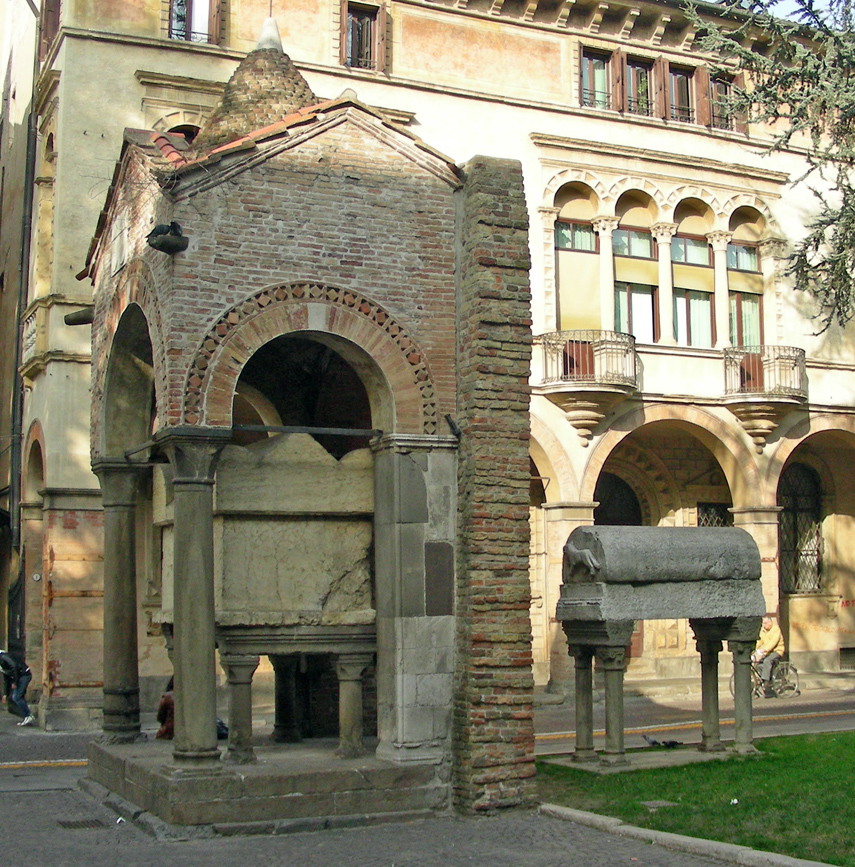Tomb Of Antenor on:
[Wikipedia]
[Google]
[Amazon]
 The Tomb of Antenor, also called the Sepulchre of Antenore, is a 13th-century monument created to honor an unearthed ancient sarcophagus, claimed to be that of the Trojan warrior and counselor
The Tomb of Antenor, also called the Sepulchre of Antenore, is a 13th-century monument created to honor an unearthed ancient sarcophagus, claimed to be that of the Trojan warrior and counselor
Tourism website for Province of Padua
 The Tomb of Antenor, also called the Sepulchre of Antenore, is a 13th-century monument created to honor an unearthed ancient sarcophagus, claimed to be that of the Trojan warrior and counselor
The Tomb of Antenor, also called the Sepulchre of Antenore, is a 13th-century monument created to honor an unearthed ancient sarcophagus, claimed to be that of the Trojan warrior and counselor Antenor
__NOTOC__
Antenor ( grc-gre, Ἀντήνωρ, ''Antḗnōr''; BC) was an Ancient Athens, Athenian Ancient Greek sculpture, sculptor. He is recorded as the creator of the Harmodius and Aristogeiton (sculpture), joint statues of the tyrannic ...
, the legendary founder of Padua
Padua ( ; it, Padova ; vec, Pàdova) is a city and ''comune'' in Veneto, northern Italy. Padua is on the river Bacchiglione, west of Venice. It is the capital of the province of Padua. It is also the economic and communications hub of the ...
; it is located in Piazza Antenore, in Padua, region of Veneto, Italy.
History
In 1274, during the construction of an orphanage in Padua, an ancient marble sarcophagus was uncovered. A local scholar, Lovato dei Lovati, said to have found inscriptions on a bronce plaque attached to the inner wooden coffin, stating the burial contained the body of Antenor. The founding of Padua by the Antenor, counselor to King Priam of Troy, who fled from the Homeric city, was likely a poetic invention ofVirgil
Publius Vergilius Maro (; traditional dates 15 October 7021 September 19 BC), usually called Virgil or Vergil ( ) in English, was an ancient Roman poet of the Augustan period. He composed three of the most famous poems in Latin literature: t ...
, who states in book 1 of the Aeneid
The ''Aeneid'' ( ; la, Aenē̆is or ) is a Latin Epic poetry, epic poem, written by Virgil between 29 and 19 BC, that tells the legendary story of Aeneas, a Troy, Trojan who fled the Trojan_War#Sack_of_Troy, fall of Troy and travelled to ...
: Antenor could escape the Achaean host, thread safely the Illyrian gulfs and inmost realms of the Liburnians, and pass the springs of Timavus, and whence through nine mouths, with a mountain’s mighty roar, it comes a bursting flood and buries the fields under its sounding sea. Yet here he set Padua’s town, a home for his Teucrians, gave a name to the race, and hung up the arms of Troy; now, settled in tranquil peace, he is at rest.Lovato commissioned the construction of the present monument, completed by 1284, consisting of a mostly freestanding open tabernacle-like structures rising above the ground, with a sarcophagus sheltered by simple
baldachin
A baldachin, or baldaquin (from it, baldacchino), is a canopy of state typically placed over an altar or throne. It had its beginnings as a cloth canopy, but in other cases it is a sturdy, permanent architectural feature, particularly over h ...
. The outdoor design recalls the display of the Scaliger tombs
The Scaliger Tombs (Italian: ''Arche scaligere'') is a group of five Gothic funerary monuments in Verona, Italy, celebrating the Scaliger family, who ruled in Verona from the 13th to the late 14th century.
The tombs are located in a court ou ...
in Verona, but this monument is earlier and simpler. The pagan founder of the town was honored in front, but not inside, the church of San Lorenzo, in a location in front of Lovato's house. Further legends grew out of the monument: for example, it was said that in 1334, the Veronese conqueror of Padua, Alberto II della Scala Alberto II della Scala (1306 – 13 September 1352) was lord of Verona from 1329 until his death. He was a member of the famous Scaliger family of northern Italy.
He was the son of Alboino I della Scala and Beatrice da Correggio. He co-ruled wi ...
, had the sarcophagus re-opened to find a golden sword.
In 1995, during restorations, an opening to the center of the sarcophagus revealed a disturbed coffin with various bones, including a skull, a female femur, and even some animal bones. Carbon-dating of a fragment of bone found dates consistent with the late Roman Empire
The Roman Empire ( la, Imperium Romanum ; grc-gre, Βασιλεία τῶν Ῥωμαίων, Basileía tôn Rhōmaíōn) was the post-Republican period of ancient Rome. As a polity, it included large territorial holdings around the Mediterr ...
, that is, the 3rd or 4th centuries.References
{{DEFAULTSORT:Antenor Ancient Roman sarcophagi Monuments and memorials in Padua